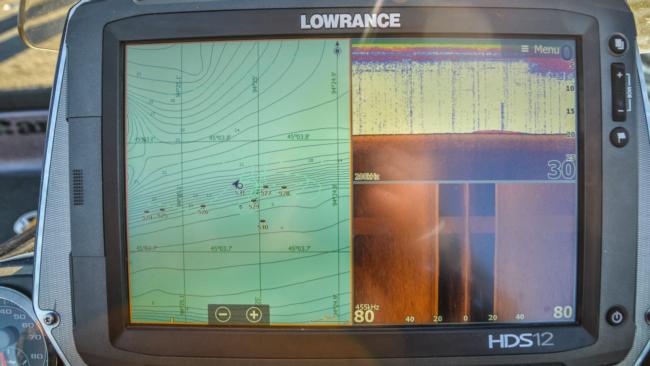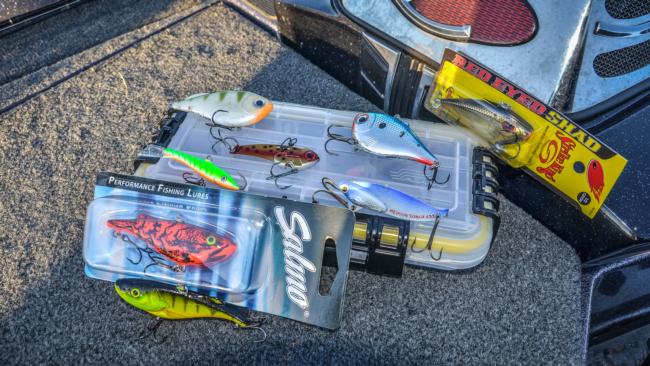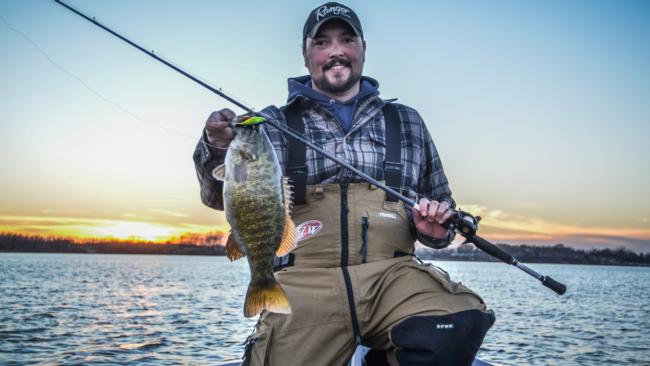Jigging Up Late Fall Smallies
How to trigger fat, aggressive brown fish

In the North Country, as fall fades and sportsmen settle in for the arrival of winter, many people put the boat away and forsake the water for the woods. For those willing to brave the elements on the lake, however, the reward is some of the best smallmouth bass fishing of the year for some of the biggest fish of the season.
Traditionally, a finesse approach is the go-to tactic for catching cold-water smallmouths. But if you want to experience some of the best bites of the season, try ripping jigging baits to draw aggressive reaction strikes.
Here’s what you need to know to jig for small jaws this time of year.
Location
Though smallmouths are notorious roamers, late fall provides a great time to pinpoint big schools that tend to set up and stay awhile in one area.
Smallies start to migrate toward their wintering areas when the water temperature creeps into the low 50s and upper 40s. They’ll stage on secondary points or steep drops coming off of large shallow flats. Most of the time the best areas are 15 to 30 feet deep, but make sure there is some deep water nearby because that is where the bass will ultimately wind up spending the winter. Depending on the lake, wintering areas could be 30 to 100 feet deep.
I usually start searching near where I encountered fish in late summer or early fall, but structure outside of spawning flats can also be a good place to begin the hunt.
Side-viewing sonar is an invaluable tool for locating these staging areas. Spend a few extra minutes graphing and studying the bottom substrate because sand-to-rock transitions are prime areas where large groups of smallies will hang out.
As a general rule, smallmouths occupy a smaller percentage of the lake this time of year than in the earlier parts of the season, so it might take some time to find them. Thankfully, when you do encounter them it doesn’t take long to get bit.
Tackle
There are a few jigging baits that I keep on hand at all times.
- No. 7 Rapala Jigging Rap
- No. 7 Rapala Rippin’ Rap
- 1/2-ounce Heddon Sonar
- No. 7 Salmo Zipper
Don’t overanalyze color selection. Keep it simple by matching the forage found in the body of water, whether it be tullibees, gobies or perch. Also, smallmouths are naturally curious creatures, so extra flash from gold- or silver-colored baits or bright colors can often help draw fish from a distance.
I like to use a 7-foot-long or longer medium-power spinning rod for the Zipper and Jigging Rap and pair it with a 20- or 30-size spinning reel and 20-pound-test braided line. These baits have small hooks, so a smooth spinning reel drag is a must to keep fish hooked up. I like to tie the braid to a small barrel swivel to help reduce line twist, and I add a 12- to 16-inch leader of 8- to 12-pound-test fluorocarbon.
When throwing the Rippin’ Rap and Sonar I opt for a baitcasting setup – a 7-foot or longer medium-power rod and a high-speed reel. For shallow water – under 20 feet deep – straight fluorocarbon in the 12- to 15-pound range does the job. For deeper water I spool up 30- or 40-pound-test braid and connect a 10- to 14-pound-test fluorocarbon leader to the main line with a swivel.
Presentation
The goal when using jigging baits is a reaction strike, and since most lures in this category are little more than a big hunk of painted metal, give the fish as little time as possible to analyze the bait.
There are really two ways to effectively work the lure: Cast it out and jig back to the boat, or vertically jig it.
Casting – This is probably my favorite way to work jigging baits in the fall – especially the Jigging Rap and Rippin’ Rap. They work wonderfully for casting because they’re heavy and compact and can cast a mile, which makes it easy to cover a structure without moving the boat much. This tactic excels when fishing smaller humps, points or flats, where fan-casting the area is more efficient than moving around on the trolling motor. It’s also a great choice in clear or shallower water.
Fire a cast out to the structure, and wait for the bait to hit the bottom. Once it hits, give the rod a short, sharp wrist snap to pop the bait off the bottom. No need to rip it hard with all of your strength. A nice snap should pop the bait about a foot off the bottom. Let it fall on slack line for the best action.
From this point it’s all about rhythm. Repeat the process until the bait is back to the boat. It helps to picture a smallmouth following the bait at all times while jigging. Creating a mental image helps to focus on your jigging cadence and the triggering qualities of the bait, as well as to anticipate the bite.
When using a spinning rod it’s also important to make sure the drag is loose enough to slip a little on the hookset. This will help to avoid ripping the hooks out of the fish’s mouth.
Vertical jigging – On the flip side, vertically jigging works well in deep-water situations or when you’re covering larger pieces of structure.
Simplicity is king for this. Drop the bait down to the bottom, and use the trolling motor to move at a speed that keeps the line sloped back at about a 45-degree angle from the rod.
The same cadence you’d use for casting works here too. When the bait hits the bottom, give the rod a sharp snap, let the bait fall on slack line and repeat. Work the area in a zigzag pattern to cover water more effectively.
The lakes are usually pretty quiet this time of year in many parts of the country, and it’s not often that you get fantastic smallmouth fishing all to yourself. Just don’t be fooled into thinking that winter’s approach means you have to go with a boring finesse presentation. Tie on a jigging bait and make a few football-sized smallmouths bite.


